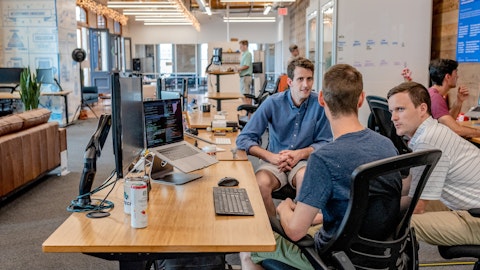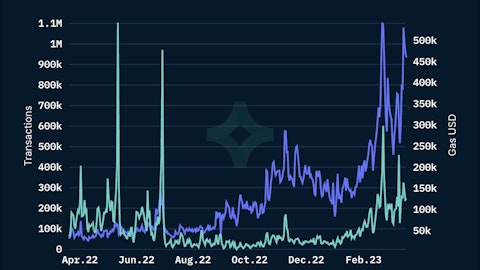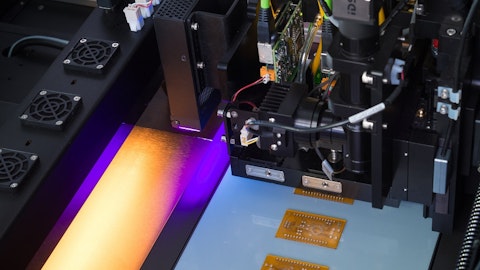will grow. We are approaching it I think right way. We’re delivering more what I would call fast. And by that, I don’t mean software as a service solution as a service, no, we don’t price it that way other than there are recurring components to the pricing model. But the idea here is that most of the other vendors are older software vendors and they’ve written a couple of apps that work. And then when you want to be a customer, they ship you a couple of tablets and a couple of printers in a box, maybe they’re getting from Zebra and maybe they get it from Epson, and in some cases, they tried to put in a little plastic container. But you’re stuck as a customer to figure this stuff out, find shelf space in the back of the house and the like, and we think that needs BOHA! Terminal that we have available now, the BOHA! Terminal 2 is a platform.
I mean, it’s got a lot of things that are kind of mundane, but they matter a lot like there’s no power block that you can trip over that if you walk through all restaurants or places where people are doing food prep, you find tablets and terminal lying all over the place. And we have a very nice modular design that is fully enabled, both from a software and a hardware standpoint. It’s telematic connected, back to a cloud, it can do WiFi, Bluetooth, near field communications, and it’s a perfect platform. And I jokingly say that, if you wanted to you could run Angry Birds in the back of the house. So anybody who’s making software that you might use in a restaurant or foodservice or [Technical Difficulty] and we’d like the opportunity and for how many users are out there online.
I’m envisioning the opportunity for us to sell additional software in there or to partner with additional programs, much like you mentioned, Jeff, to say, hey, we can ship our box with your offering or you can ship or we can ship your offer with our box and or we can have a joint sale opportunity. And I think it’s early days, but that’s a key area that I’m following up on. And Jeff, I wish I had had, you know, some color commentary besides what I’m talking about now, they going to say this is what we’re doing, this is where you can expect it to be. But I think it’s a key part of what we’re doing. And I believe as the adoption cycle accelerates in the foodservice technology space, you’re going to see platforms if we’re looking at roll, right.
Jeff Martin: Great, so John, your cellphone has been cutting in and out a bit throughout the call. I think we’re done with that. It’s things, but just as a has a fair warning.
John Dillon: Thank you.
Jeff Martin: My question relates to the types of end markets that you’re I’m looking at when you talk about the pipeline being up — 160% or so. Could you characterize the qualified near term 12-month pipeline in terms of maybe C-stores, QSRs, restaurant groups and the like?
John Dillon: Yeah, I don’t have the specific numbers in front of me. We have a team dedicated to about four or five of the sub verticals. We have QSR, of course, we have casual and fine dining, we have grocery, we have grab-and-go, and we had food service management. I would say, from an opportunity standpoint, it’s about even. Even though in some cases like a QSR could have 1,000 stores, 1,000 shops, whereas you do it in who’s a foodservice management firm, I have a very different operation, not lots of units but big units. And so from a unit standpoint, it’s pretty much spread evenly and the sales team is targeting each one of those. We’ve implemented some account-based marketing, which is sort of like looking at who you’re trying to sell to and then who in that organization, do you need to know.
And then how do we reach those people. And a little bit of color commentary [Technical Difficulty] I think Jeffrey have implemented and are continuing to enhance is essentially an average frac. A lot of companies if I talk to say that sounds great and they don’t say no, and the math say anything at all, but really have not no, but not now. And is they may have five other projects underway; they might be building new distribution centers. We have one of our large, I guess, convenience store customers. Put a pause on buying our machines and our systems because they were reconfiguring their stores. Or and in the same case, they had a large acquisition they had to consume. But the point is, is that so we’ve got to nurture track where we actually stay in touch with these people, instead of letting them fall on the floor.
And it’s just good sales process. It’s all part of the go-to market and the idea that the marketing department can deliver, if you will, a conversation-ready prospect to the sales team, as part of the efficiency that we’re baking into the whole GTM process as a whole. And its early days, but we’re beginning to see real progress there. We go to a tradeshow or we do outbound. We get some lead. We begin the conversation and our engaging with them through a nurture track, which might be six, 12 months. Sometimes it might take that long for a large organization to say, okay, I’m ready. And we want to be there when they’re ready, we want to keep them apprised of the progress we’re making other clients in the same industry that have adopted the technology and are seeing the savings and the benefits.
So all of these things that we’ve implemented, none of them are rocket science, but they’re very appropriate for the third decade of the 21st century, and that’s where we are now. And I think you’re beginning to see, if you will, the light at the end of the tunnel. The numbers are up, the pipeline is much, much better than it was six months ago. And I think I think we’re on the way. We’ve still got a lot of work to do. Selling to the enterprise customers is going to be somewhat lumpy. I’m hoping to have progressively better results every quarter forever. The reality is it’s going to be up down back to the original 14,000 plus units that are out there. The more other technology that we can say, hey, all you have to do is download this or we can push it, you can run it, you pay us a little bit of money every month or every quarter.
I like that model that recurring business is something that we’re going to be focused on are focused on now, but we think there’s a lot of potential there. And that plays back to the original question, which is who you are working with it might participate in that ecosystem. And like I said, its early days, but it’s a key focus of mine and the team.
Operator: We have reached the end of our questions-and-answer session. I would like to turn the conference back over to John Dillon for closing comments.
John Dillon: Well, listen, I don’t have a lot of extra things to say. We’re excited about this quarter, even though the gaming and casino industry’s been up and down. I’m disappointed that it’s that way, but, you know, it’s not broken. It’s just that a disequilibrium. And all the system that disequilibrium usually regress to a mean or norm, and that’s what we expect. We look forward to talking to some of you individually. And again, I will continue to focus on transparency and share as much as possible with you as I can. And godspeed and I appreciate your time and attention to this call, and we look forward to working with you through the quarter.
Operator: Thank you. This will conclude today’s conference. You may disconnect your lines at this time and thank you for your participation.




